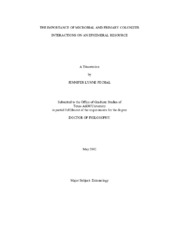| dc.contributor.advisor | Tomberlin, Jeffery K. | |
| dc.creator | Pechal, Jennifer | |
| dc.date.accessioned | 2012-07-16T15:58:19Z | |
| dc.date.accessioned | 2012-07-16T20:30:57Z | |
| dc.date.available | 2014-09-16T07:28:21Z | |
| dc.date.created | 2012-05 | |
| dc.date.issued | 2012-07-16 | |
| dc.date.submitted | May 2012 | |
| dc.identifier.uri | https://hdl.handle.net/1969.1/ETD-TAMU-2012-05-11016 | |
| dc.description.abstract | Carrion decomposition is an essential ecosystem function as it is an important component of nutrient cycling. Carrion decomposition has primarily been attributed to insect consumption, with little attention given to microbial communities or their potential interactions with insects. The first objective was to use passive insect-trapping methods to assess primary colonizer communities on swine carcasses between two treatments: 1) carrion with access to insects and 2) carrion excluded from insect access for five days using exclusion cages. Despite similarities between succession patterns within each treatment, carcasses initially exposed to insects had significantly fewer insect taxa. Therefore, collections of adult insect communities associated with carrion are promising as an indication of whether or not there has been a delay in insect colonization of a resource.
There has yet to be a study documenting bacterial communities during carrion decomposition. The second objective was to describe bacterial community succession and composition during decomposition in the presence and absence of naturally occurring insects. Total genomic DNA was used to identify bacterial community composition via a modified bacterial tagged encoded FLX amplicon pyrosequencing. I obtained 378,904 sequences and documented distinct bacterial community successional trajectories associated with insect access and exclusion carcasses. By the fifth day of decomposition, Proteus was the dominant (72%) bacterial genus on exclusion carcasses while Psychrobacillus (58%) and Ignatzschineria (18%) were dominant bacterial genera on insect carcasses. These data are the first to document bacterial community composition and succession on carrion.
My final objective was to assess microbial community function in response to carrion insect colonization using metabolic profiling. I characterized microbial community metabolic function in the presence and absence of the primary necrophagous insects. I documented significant microbial community metabolic profile changes during active decomposition of carcasses. Mean carcass microbial community metabolic function with insect access continuously decreased over decomposition during both field seasons. Thus demonstrating microbial metabolic activity may have discriminatory power to differentiate early and late stages of decomposition.
Overall, my data contributes to an understudied area of microbial research important to organic matter decomposition, forensic entomology, and microbial-insect ecological interactions. | en |
| dc.format.mimetype | application/pdf | |
| dc.language.iso | en_US | |
| dc.subject | decomposition ecology | en |
| dc.subject | carrion | en |
| dc.subject | forensic entomology | en |
| dc.subject | microbial communities | en |
| dc.subject | Biolog ECOplates | en |
| dc.subject | 454-pyrosequencing | en |
| dc.title | The Importance of Microbial and Primary Colonizer Interactions on an Ephemeral Resource | en |
| dc.type | Thesis | en |
| thesis.degree.department | Entomology | en |
| thesis.degree.discipline | Entomology | en |
| thesis.degree.grantor | Texas A&M University | en |
| thesis.degree.name | Doctor of Philosophy | en |
| thesis.degree.level | Doctoral | en |
| dc.contributor.committeeMember | Tarone, Aaron M. | |
| dc.contributor.committeeMember | Eubanks, Micky D. | |
| dc.contributor.committeeMember | Crippen, Tawni L. | |
| dc.contributor.committeeMember | Benbow, Mark E. | |
| dc.type.genre | thesis | en |
| dc.type.material | text | en |
| local.embargo.terms | 2014-07-16 | |


